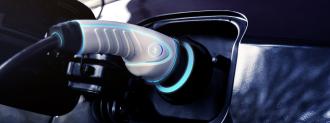Harvard University researchers have made a breakthrough in battery tech: a long-lasting solid-state lithium battery.
“A lithium-metal battery is considered the holy grail for battery chemistry,” researcher Xin Li told the Harvard Gazette.
Strong, cheaper, faster: Most of today’s electric vehicles (EVs) are powered by lithium-ion batteries, the same type of battery you’ll find in your laptop or smartphone.
These batteries degrade quickly and take a long time to charge. They also sometimes catch on fire — all features that can dissuade people from switching to an EV.
Harvard claims its new solid-state lithium battery can be charged and discharged at least 10,000 times. That could increase the life expectancy of an EV battery to 15 years — currently, most are only warranted for 8 years or 100,000 miles.
The battery could also allow people to fully charge their EVs in just 10 to 20 minutes.
Battery basics: Batteries have four main components: a cathode (positively charged), an anode (negatively charged), a separator (so they don’t touch), and an electrolyte (a liquid or gel that carries the current from one side to the other).
When the battery is in use, ions in the electrolyte move from the anode to the cathode, creating an electric current to power a device. When the battery is charging, they move back to the anode.
The challenge: A solid-state lithium battery replaces the liquid electrolyte with one made of a solid material, usually some type of ceramic. It also replaces the heavy anode, usually made from graphite, with a lighter one made of lithium metal and just a coating of graphite.
These changes reduce the risk of fire and allow the battery to charge more quickly and hold more energy.
However, needle-like structures called dendrites can form on the anode of a solid-state lithium battery. The little spikes can then pierce through the ceramic, causing the battery to short circuit.
Our strategy to stabilize the battery feels counterintuitive.
Luhan Ye
How it works: To avoid this issue, the Harvard team developed a solid-state battery with two different electrolytes: one that’s prone to dendrite penetration but more stable, and the other that’s less stable but dendrite-proof.
They sandwiched this second type of electrolyte between layers of the first. Dendrites could then penetrate the layers containing the first electrolyte, but because they couldn’t breach the layer containing the second, they couldn’t cause the battery to short circuit.
“Our strategy of incorporating instability in order to stabilize the battery feels counterintuitive but just like an anchor can guide and control a screw going into a wall, so too can our multilayer design guide and control the growth of dendrites,” co-author Luhan Ye explained.
As a bonus, the chemistry of Harvard’s solid-state lithium battery causes it to fill any holes caused by the dendrites, meaning it essentially heals itself.
Battery companies say one thing, automakers say another thing.
Xin Li
The cold water: Harvard has only made a coin-sized prototype of its solid-state, lithium-metal battery so far. To power a vehicle, we’d need something about the size of a textbook — and getting to that point won’t be easy.
“Scaling up to EVs is not a trivial problem — there are many engineering aspects we’ll have to figure out later,” Li told IEEE Spectrum.
As for when anyone might be able to buy an EV containing Harvard’s solid-state lithium battery, that depends who you ask, according to Li.
“Battery companies say one thing, automakers say another thing,” he said. “My guess is five to 10 years.”
We’d love to hear from you! If you have a comment about this article or if you have a tip for a future Freethink story, please email us at [email protected].






